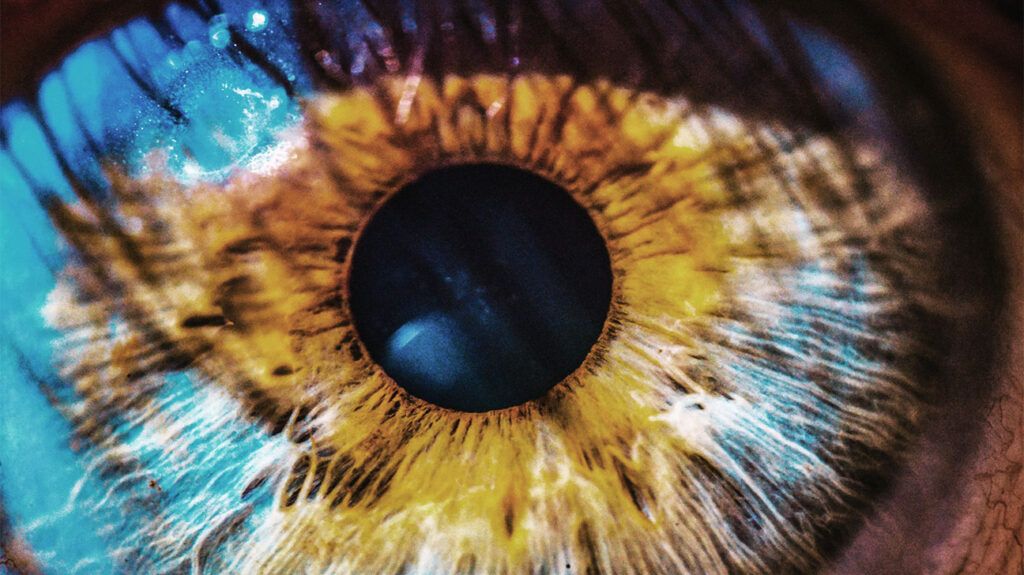Neovascular age-related macular degeneration (NVAMD) is a more severe type of AMD. The characteristic features of NVAMD are new, fragile blood vessels that leak fluid and damage the macula.
Also known as exudative or wet age-related macular degeneration (AMD), NVAMD describes a progressive eye disease that can affect a person’s vision. The development of new, leaky blood vessels in the eye is the defining feature of NVAMD. Neovascularization is a term health experts use to describe the formation of new blood vessels.
The new blood vessels are fragile, which means they are prone to leaking blood and fluid. When these blood vessels leak, it can scar and damage the macula, which is the part of the eye responsible for central vision. As such, the condition’s progression can result in blank spots and central vision loss.

While wet AMD is less common, it is the more serious type of late stage AMD. It is also
The defining characteristic of wet AMD is the presence of new abnormal blood vessels. These blood vessels grow in the back of the eye and damage the macula. Health experts refer to the process of new blood vessel growth as neovascularization. Specifically with AMD, medical professionals may also refer to the new blood vessels as macular neovascular membranes or
These new blood vessels are weak and
The fluid from leaky blood vessels can lead to scarring of the macula. This is part of the eye responsible for central vision. As such, damage from wet AMD can result in a rapid loss of central vision.
AMD is a progressive condition. This means that symptoms of AMD typically get worse over time. There are two types of AMD: dry and wet.
Dry AMD is the more common type of AMD and typically occurs as the macula gets thinner with age. There are
Early dry AMD often causes no symptoms. People may begin to notice mild symptoms with intermediate AMD, such as mild blurriness or difficulty seeing in low lighting. Late dry AMD is the most advanced stage. People may also begin to notice blank spots in their vision and that colors are less vibrant.
Read on to learn more about wet vs. dry AMD.
Any stage of dry AMD can progress into wet AMD. However, while dry AMD progresses through stages, wet AMD is always late stage. With wet AMD, symptoms can worsen rapidly and vision loss can progress faster than dry AMD. This is due to the presence of new, abnormal blood vessels leaking blood and other fluids, which damage the macula.
Read on to learn more about the progression of wet AMD.
If a person has NVAMD, they may experience the following symptoms:
- central vision loss
- blank spots in their vision
- visual distortion, which may cause straight lines to appear wavy
- colors appearing less vibrant
- difficulty seeing in low lighting
Read on to learn more about the symptoms of wet AMD.
Currently, researchers are unsure of the exact mechanism of how NVAMD develops. However,
NVAMD occurs when new, leaky blood vessels develop and damage the macula. Angiogenesis is a term that describes the formation of new blood vessels. Many different angiogenic factors can
For example, evidence notes that NVAMD may occur due to an
The American Academy of Ophthalmology (AAO) also notes that risk factors for AMD may include:
- being over 50 years old
- having a family history of macular degeneration
- being white
- eating a diet high in saturated fats
- having excess weight or obesity
- smoking cigarettes
- having high blood pressure
Treatment options are available that
Anti-VEGF injections are medications a doctor can inject directly into the eye. As too much VEGF protein likely plays a role in the development of atypical blood vessels, these injections aim to block VEGF proteins and stop any further damage.
Photodynamic therapy (PDT) is a form of laser therapy. A doctor injects a light-sensitive medication that can help break down abnormal blood vessels. A doctor can activate the drug by shining a laser light into the eye. The drug is then able to seal leaky blood vessels.
Researchers are also investigating the use of monoclonal antibodies. These refer to antibodies that scientists can design to target specific antigens. In 2022, the Food and Drug Administration (FDA) approved faricimab-svoa for treating NVAMD. This monoclonal antibody works by blocking VEGF and angiopoietin-2 (Ang-2) proteins, both of which can lead to NVAMD.
Ongoing research is also investigating the use of gene therapy for treating NVAMD. These new therapies will aim to encourage the cells in the eye to produce proteins to prevent the development of new, atypical blood vessels. For example, a
Read on to learn more about treatment for wet AMD.
Neovascular age-related macular degeneration (NVAMD), also known as wet age-related macular degeneration (AMD), describes a late stage eye disease that can cause vision loss.
The characteristic feature of NVAMD is the presence of new, abnormal blood vessels. Neovascularization is a term that describes the formation of new blood vessels. These new blood vessels are fragile and can leak fluid, which is the origin of the name “wet” AMD.
The leakage of blood and fluid from these blood vessels can damage the macula, leading to vision loss. Treatment options aim to slow or stop vision loss by sealing and preventing the growth of new blood vessels.
